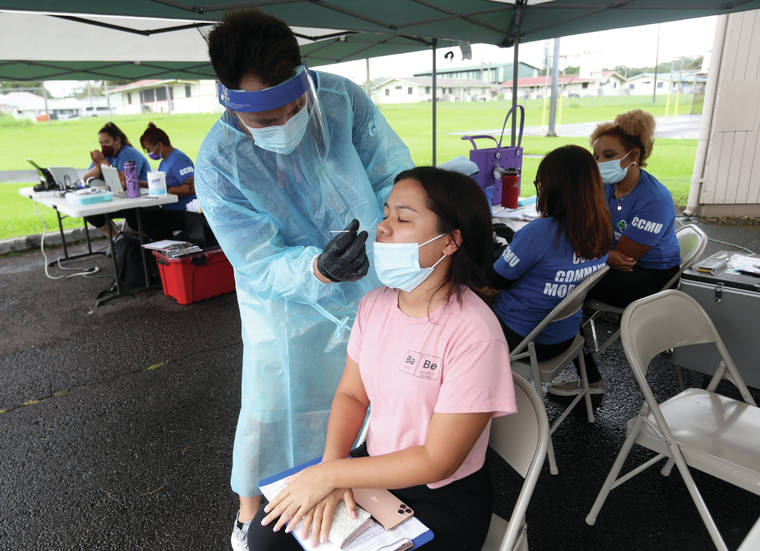Friday marked the largest single-day COVID-19 case count in Hawaii since the pandemic began early last year.
The state Department of Health reported a recording-breaking 622 confirmed and probable new cases, of which 111 were on the Big Island.
Hawaii County now has a 6.8% test positivity rate, the highest in the state.
“As you know, we had data issues earlier this week, but if you take those counts and you look at the past three days, it would be an average of over 300 cases a day … ,” State Health Director Dr. Libby Char said during a livestream Friday morning. “Certainly what we want to look at are trends, and we know from the past couple of weeks, our trends have gone from the 40s to the 60s to 160s to 200s and now 300, so very, very concerning.”
Some cases were not reported earlier in the week due to an electronic reporting interruption.
Hawaii Island acting District Health Officer Jason Dela Cruz said in a call to the Tribune-Herald that spiking individual daily cases can be alarming, but people should pay attention to daily averages and test positivity rates as well, which are measured over time.
“In order to understand where we are in this cycle, we need to start looking at time-based metrics, not just a daily count,” he said.
Char said “there’s no real reason to think the trend will change without us doing something different.”
According to Char, vaccination remains the top tool in fighting the pandemic.
“We know it’s safe, and we know it works,” she said. “So get vaccinated, wear your mask — that’s another tool that we know is absolutely effective — keep your distance, and what we’re seeing more of that we need to remember is stay at home when you’re sick. We’re seeing more spread through people who have symptoms, even if they’re minor, being out and about going to work, mingling with family members and spreading the virus.”
Gov. David Ige echoed those sentiments in a news conference Friday afternoon.
“The pandemic is not over, and the best way forward is for people to get vaccinated,” he said. “We do know the vaccinations are safe. It’s the best way to keep our community healthy and safe.”
Ige, however, said there has been an increase in cases among those who are vaccinated.
“It’s a very small percentage of the cases, but in most instances, those who are vaccinated who became infected with COVID had dropped their guard a little.”
Char said during the news conference that those breakthrough cases account for 0.06%, or roughly six people out of 10,000, becoming infected after they’ve been fully vaccinated. Infections among those who are not vaccinated are significantly higher at 300 people per 10,000.
On Thursday, the state reported that 60% of residents were fully vaccinated against COVID-19, three weeks after Hawaii was expected to hit that benchmark.
Ige implemented changes to the state’s travel and gathering restrictions on July 8, the date that 60% of Hawaii’s population was expected to be fully inoculated.
He has said previously that when the state reaches a fully vaccinated rate of 70%, all of Hawaii’s COVID-related emergency restrictions will be dropped, and the state’s Safe Travels Program will end.
“We haven’t made determination of changing the 70% target,” the governor said. “We do believe we need to continue to work to get everyone in our community who’s eligible to get vaccinated, but we do believe that the 70% target is still a good target and goal to drive toward. We do know and we have more information about the Delta variant. We are aware that it is more transmissible and certainly we’ll be looking at that as we proceed forward, but at this point in time, we are maintaining the goal of 70% fully vaccinated in our community.”
It was previously projected that if the pace of vaccines held at 15,000 doses per week, the state would hit the 70% threshold in early September.
“Obviously, we’ve fallen behind schedule,” Ige said. “… But we have noticed over the last several days there has been an increase in vaccinations.”
The current surge in cases comes as students and teachers prepare to return to classrooms next week.
Char said it is safe for students to be back in school.
“There is risk involved in everything, but I think we also have to be cognizant that there is a cost to not having children in school and having them fall further behind in learning and the continued social isolation,” she said.
The DOH recently released guidance for schools, outlining essential safety protocols and other mitigation steps that can be layered to reduce the spread of COVID-19.
“There’s no one school that’s going to probably adopt every single recommendation, but the more that we can adopt, those are just added layers of safety,” Char said. “So yes, there is a risk, and I imagine when we start school … there will be some people that have COVID that are going to show up. So we will see some rises, but we’re trying to also structure it so that it will minimize the amount of spread in any setting, and so it will keep as many people safe as we can.”
Among other COVID-related topics discussed Friday, Ige said the eviction moratorium is still set to end on Aug. 6.
And when asked about vaccine requirements for state employees, the governor said he’s evaluating what the federal government is doing regarding vaccine requirements.
President Joe Biden this week announced that federal employees must show proof of vaccination or submit to weekly testing and other safety measures.
“So we are working to get information about how they would be implementing and what the parameters and requirements would be, and certainly we are having discussions about state and county employees,” Ige said.
Email Stephanie Salmons at ssalmons@hawaiitribune-herald.com.



